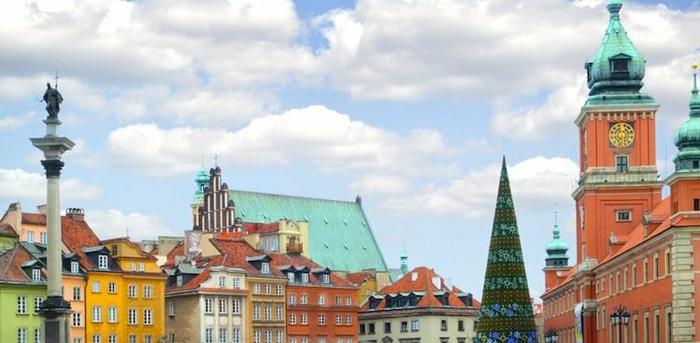
No matter where I am in the world, one thing stays the same: The holiday season is all about food and family. That said, Christmas is celebrated a little bit differently everywhere I’ve been, and I love learning about other cultural traditions and even adding some globally inspired customs to my own holiday table.
If you want to bring a bit of your heritage into your holiday celebrations (or just get inspired for an upcoming trip), read on for a peek into how six countries around the world spend the Christmas season.
Poland
In my home country of Poland, Christmas Eve is often seen as the start of the new year. We celebrate Christmas Eve by breaking oplatek, a special Christmas wafer, and wishing each person health, happiness, and joy in the coming year. Dinner will be anywhere from five to 13 dishes and will consist of pierogis filled with cheese and potatoes, beet soup (borscht) or wild mushroom soup, and a number of fish and vegetable entrees. In addition to traditional ornaments, the tree is often decorated with Polish chocolate filled with liqueurs, as well as spiced apples and oranges which are gradually snacked on throughout the holiday.
Norway
A main event for children in the Norwegian celebration is Saint Lucia Day on December 13. While the holiday doesn’t take precedence over Christmas, it is celebrated in schools across the country with a procession to symbolize the light overcoming the darkness. One young woman is picked to lead the procession wearing a crown of candles, and the other young students follow her, also holding candles and singing a carol called “Sankta Lucia.” Later, back at school the children eat a saffron bun called “Lussekatter” (which translates to Lucia cats, because the bun has a tail).
Mexico
In Mexico, as well as many other Latin American countries, Christmas is seen as a quieter, solemn holiday, while Three Kings Day (Día De Los Reyes) in early January is a day for partying and exchanging gifts. Many children who celebrate Three Kings Day leave out their shoes in hopes that one of the Three Wise Men will leave them gifts. The sharing of rosca de reyes (Three Kings Day bread) is common, and there is either a coin or a small doll of Jesus hidden inside the bread. And whoever finds the doll in his or her piece of bread has to provide the tamales for the upcoming party!
India
In the South of India, in places like Goa and Kerala, Christmas is widely celebrated, and it’s becoming more popular in places like Mumbai, as well. The holiday is celebrated with firecrackers and the purchasing of new clothes and shoes on Christmas Eve. Traditional pine trees are tough to find, so mango or banana trees are decorated in garlands made of palm fronds with small stones and dolls, or are painted gold. The traditional dish served on Christmas is Pork Vindaloo, and neighbors often exchange home-baked sweets including Kulkuls and gujiyas.
Kenya
In Kenya, the trek home is an important part of Christmas, as many young professional Kenyans who work in cities like Nairobi and Mombasa make the long journey back to their villages to be with family. The holiday journey home can be chaotic, because everyone is trying to get home on buses, vans, and whatever transport is available, but the season is a time for young professionals to reflect on their origins as well as honor older generations.
Christmas Day is also about making a fashion statement, as many young Kenyans wear special Christmas clothes to church, really dressing to impress. After church, Kenyans eat traditional chapati and goat meat or kibokoni mbuzi, traditional goat curry.
Philippines
The Philippines has one of the longest holiday seasons in the world, starting in September and ending around January 9. Christmas plays, parties, and decorations are in full swing throughout these months, and there are nine night Masses (known as Simbang Gabi) leading up to Christmas Day. The belief is that, if you attend all the Masses, you will get a wish granted in the upcoming year.
When Christmas Eve, or Nochebuena, is celebrated, families indulge in a regional hybrid of local foods like lumpia sariwa, a fresh spring roll, morcon, a meat roll stuffed with sausage, pickles, cheese, and egg, and paella.
Whether you’re traveling around the world, or just headed home to spend your holiday season, embracing new and unique traditions is a great way to travel the world from the comfort of your own home and prepare for a fresh and brilliant year ahead. I wish you a happy and worldly holiday and much travel, adventure, and success in the coming year!